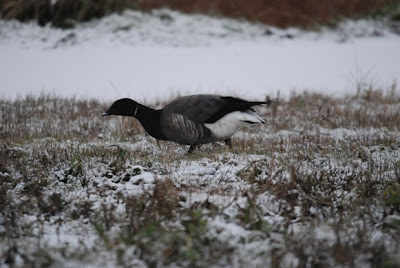 |
| Corn Buntings |
Throughout the course of the late morning/afternoon the camera remained on ISO 1600, so apologies for the crap photo’s.
 |
| Marsh Harrier |
 |
| Ringtail Hen Harrier |
Started off at the RAPTOR WATCHPOINT down Harty Lane, in past years I have had up to 12 Marsh Harriers in view at the same time, today the most I could manage was only 4 separate birds, these were all in view at the same time. Scanning around provided no other sightings so presumably many have dispersed southwards due to the extreme weather.
I was hoping for an adult male Hen Harrier but could not complain with 2 Ring Tails seen off and on for over an hour, again I had both in view at the same time, even managed some dodgy photo’s. Whilst scanning I could hear Geese calling all the time and even had a skein of White Fronts overhead, even as I watched they started to drop, so headed over in that direction.
 |
| White Fronted Geese |
 |
| Quite a sight |
The bridle path came up trumps with a flock of around 60 Chaffinches, 5 Brambling and 12 House Sparrows. Best of all was a Tree Sparrow in with the Houses. Beyond this, in distant fields was an enormous flock of Geese, a large proportion Greylags, even at this distance I could pick out Whitefronts and Barnacles, as I scanned I picked up 2 very interesting birds that may well have been Pinkfeet Geese. As I watched the whole field took flight as a Marsh Harrier crossed overhead, the sight and noise was spectacular, probably around 500 Geese, magical to watch.
 |
| Brambling and Chaffinch |
 |
| Brambling |
Decided to retrace my steps and walked out along the other footpath after seeing a good size flock drop in closer in a nearer field. Scoping through them produced 64 White Fronted and 37 Barnacle Geese, of the 2 I had seen briefly I could not locate.
Other species seen were
Common Buzzard – 1 on the A2 sitting on the lights
Sparrowhawk – 2 females seen
Kestrel – 1 down Harty Lane
Golden Plover – 11 in with Lapwing
Waxwing – 1 in with the hordes of Fieldfare and Redwing along the entrance road
Corn Bunting – 28 on the wires and bramble
Stonechat – 1 male
No Merlin or Peregrine sightings or Short Eared Owls, from talking to a local birder it seems the SEO’s are seen more at Shellness.
 |
| Barnacle Geese |
 |
| White Fronted Goose |












































